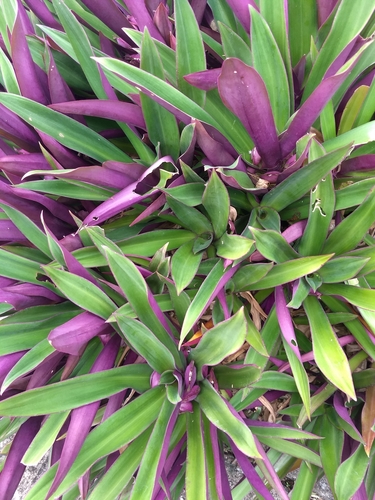Moses-in-the-cradle
Search
Wikipedia
| Tradescantia spathacea | |
|---|---|

| |
|
Scientific classification | |
| Kingdom: | Plantae |
| Clade: | Tracheophytes |
| Clade: | Angiosperms |
| Clade: | Monocots |
| Clade: | Commelinids |
| Order: | Commelinales |
| Family: | Commelinaceae |
| Genus: | Tradescantia |
| Species: |
T. spathacea
|
| Binomial name | |
|
Tradescantia spathacea | |
| Synonyms[1] | |
|
List
| |
Tradescantia spathacea, the boatlily[2] or Moses-in-the-cradle, is a herb in the Commelinaceae family first described in 1788. It is native to Belize, Guatemala, and southern Mexico (Chiapas, Tabasco, and the Yucatán Peninsula) but widely cultivated as an ornamental and naturalized in parts of Florida, Texas, Hawaii, and various oceanic islands.[3][4][5]
Description
Tradescantia spathacea has fleshy rhizomes and rosettes of waxy lance-shaped leaves. Leaves are dark to metallic green above, with glossy purple underneath. These will reach up to 0.30 m (1 ft) long by 76 mm (3 in) wide. They are very attractive foliage plants that will reach 0.30 m (1 ft) tall. They are hardy in USDA zones 9-12 and are also grown as ornamental houseplants.
Invasiveness
Tradescantia spathacea has naturalized in Florida and Louisiana and is listed as a Category II invasive exotic species by the Florida Exotic Pest Plant Council. "This means Invasive exotics that have increased in abundance or frequency but have not yet altered Florida plant communities to the extent shown by Category I species. These species may become ranked Category I if ecological damage is demonstrated."[6]

References
- ^ "Tradescantia spathacea Sw". Plants of the World Online. Board of Trustees of the Royal Botanic Gardens, Kew. 2017. Retrieved 27 September 2020.
- ^ "Tradescantia spathacea". Natural Resources Conservation Service PLANTS Database. USDA. Retrieved 14 December 2015.
- ^ Kew World Checklist of Selected Plant Families
- ^ Biota of North America Program 2013 county distribution map
- ^ Hunt, D. R. 1994. 257. Commelinaceae. 6: 157–173. In G. Davidse, M. Sousa Sánchez & A.O. Chater (eds.) Flora Mesoamericana. Universidad Nacional Autónoma de México, México, D. F.
- ^ Florida Exotic Pest Plant Council (2017). "Florida Exotic Pest Plant Council's 2017 List of Invasive Plant Species" (PDF). Retrieved 14 March 2019.
| Wikimedia Commons has media related to Tradescantia spathacea. |
